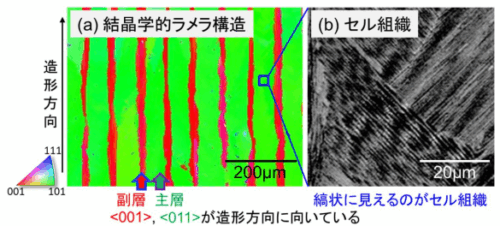2025-06-24 大阪大学,科学技術振興機構

図 1 IN718 合金にて得ている、マイクロメートルスケールの結晶学的ラメラ構造とナノメートルスケールのセル組織が共存した LPBF 造形体の組織。(a)の緑の部分と赤の部分は、結晶方位が異なっている。(b)はセル組織の配列を示しており、LPBF 材における高強度化の原因となる組織であることが判明。
<関連情報>
- https://www.jst.go.jp/pr/announce/20250624/index.html
- https://www.jst.go.jp/pr/announce/20250624/pdf/20250624.pdf
- https://www.tandfonline.com/doi/full/10.1080/21663831.2025.2522801
レーザー粉末床溶融インコネル718におけるセルの顕著な強化効果 Remarkable strengthening effects of cells in laser powder bed fusion-processed Inconel 718
Taichi Kikukawa,Takuya Ishimoto,Hyoung Seop Kim & Takayoshi Nakano
Materials Research Letters Publishe:24 Jun 2025
DOI:https://doi.org/10.1080/21663831.2025.2522801
Abstract
Alloys fabricated via laser powder bed fusion (LPBF) exhibit superior strength. This study investigates the individual strengthening effects of the nanometre-sized cellular and micrometre-sized crystallographic lamellar structures in the LPBF-fabricated Inconel 718 alloy by selectively eliminating these structures through heat treatment and a novel laser scanning strategy, respectively. While cellular structures increased the yield strength by approximately 38%, lamellar structures contributed to only a marginal 2% increase. This finding demonstrates the remarkable strengthening effect of cells on LPBF products. This study highlights that cells are not merely microstructures but are critical features governing the exceptional strength of LPBF products.


